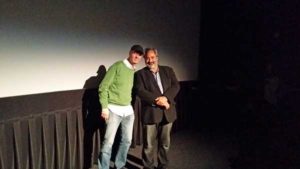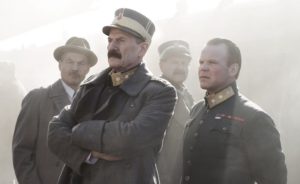
The King’s Choice is a film that tells the story of a three-day pivotal period in the history of Norway. Engrossing and with somewhat grim parallels to our current world political situation, the story begins on April 9th, 1940 with the German Navy, led by the flagship Blücher sailing unannounced into Norwegian harbor, supposedly to “rescue” them from invasion by the British who had already mined their harbors. The true purpose was to secure the ports of Norway as well as secure Germany’s supplies of iron ore from Sweden.
The film combines the best of political machinations, escalating images of war and most of all human drama. Poppe, who is a former war photographer explained, “I want to remind the people about what war really is. Too often in films, it’s depicted with soaring music and epic images, almost like an opera. There are no heroes, only people desperately trying to do what they believe they should. That is the real face of war.”
Poppe also explained prior to the screening a little bit about the political structure of Norway, saying that their king was elected by the people and if you pictured the chain of command as a pyramid the people would be on the top, the cabinet, led by the prime minister next and then the king at the bottom. The king is there mainly to give balance to the whole.
This was important to understand to comprehend the tensions between the factions, which basically consisted of a panicking council, a king not wanting to overstep the will of the people by intervening before the council, his son, frustrated by the lack of action by both the council and his father and a frantic German consulate who was an unpopular seeker of peace in a regime ravenous for war.
The acting was superlative with all three main characters, Jesper Christensen playing King Haakon VII, Karl Markovics, who played Kurt Bräuer, the German ambassador and one of Norway’s biggest stars Anders Baasmo Christiansen who played the king’s son, Olav, conveying the sense of escalating danger and frustration capitulating Norway into abandoning their neutrality and declaring war on Germany.
With a budget of somewhere between seven and eight million dollars, shooting took place over 39 days in Sweden, Denmark and Norway during 2015 and used many of the actual locations where the events depicted took place. It was the first time a film production was given access to Norway’s Royal Palace. The home of the crown prince and crown princess, the cars and the train that the family actually used when fleeing the Germans, and the site of the King’s fateful meeting with Bräuer are all authentic.
Shooting was done with Alexa cameras with heavier and older lenses to give a diffused look to the digital filming. The camera work was all handheld because Poppe wanted an organic look to the film, almost the look of a documentary.

Poppe recounted the story of himself holding a camera and leaning against what looked like a solid wall in the castle where they were filming, and hearing the current King Harald V of Norway telling someone on the phone, “I need to be quiet, they are filming a movie here.”
There was also a considerable amount of CG work used to recreate World War II–era Norway. “Basically all the exteriors in Oslo are digital paintings,” said Poppe. “We had to build the train station digitally. I’m quite proud of the work, because there’s a lot of it, and I don’t think you can see it. We have made it look as natural as possible.”
Poppe shared that the film took four years to make because it was so heavily researched and that he, in fact, had close to one hundred assistant directors, all in their 90’s who participated in and survived this 3-day period in history and assisted in making sure that every detail of the film was historically accurate. “We realized that there was an urgency to get this film made as soon as we could so that the information was not lost. As it was, we lost over half of the people we consulted with over the time that the film was being researched,” said Poppe.
The film officially opened in Norway on September 23, 2016, to huge acclaim and rave reviews, quickly becoming the country’s highest-grossing film of the year.
Despite the actions of king and country, Norway was woefully outgunned by German forces. Norway was occupied by the Germans from April 9, 1940 to May 8, 1945. Some 80,000 refugees fled the country along with the royal family and members of the council.
“History tells us that there are good guys and bad guys. We like to see in black and white, but that is actually a rarity. I need to go as deep as I can into the characters, to bring them to you as a story about human nature that stays in the body and in the brain,” said Poppe.





